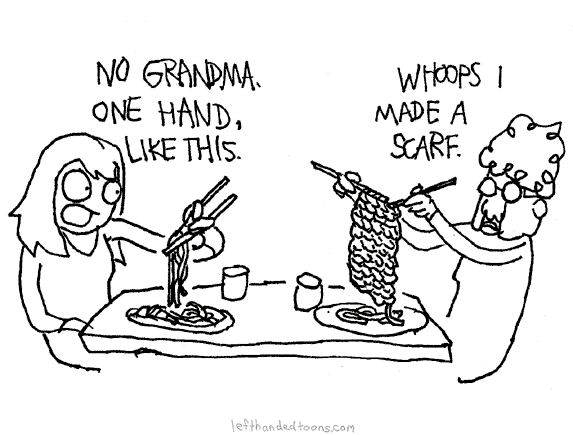Or perhaps not.
Dorothy, my mother-in-law (and Goddess of Intarsia), must have been appalled as she looked down from her heavenly rocking chair at Nancy the naive knitter. She would have recognized that I was lacking in so many skills that would have made pattern-knitting easier. I was unable to finesse the many strands of wool necessary to create the pattern. I got lost trying to follow the instructions. I couldn't count the stitches accurately. And I was far too distractable. Did I really think I could simultaneously count Nevada roadside prisons and the correct number of stitches for a good-looking little yellow tail?
In fact, I briefly toyed with the idea of re-defining "correct". Bruce, who watched me knit and rip and curse, and re-knit legs and spots and tail from Canada to California and back, actually encouraged me to fudge a little. "What is the correct appearance for a tail?" he argued. "Why can't a spot be fatter or thinner?" And I did briefly try to incorporate my mistakes into the body of the giraffe. But it didn't look right. And it didn't feel right either. I didn't want to pretend that my errors were deliberate. And I knew it wouldn't work, anyway: I would know. I recalled that my mother (a knitting dabbler, unlike Dorothy) once attempted one of those intarsia-knitted cutsie-sweaters for me. The pattern showed two large, white geese on a navy background. When she had completed the sweater, she passed it to me, looked at it, and then took it back. "I can't give this to you", she said. "I've forgotten a goose."
I returned from our trip last September with a completed sweater-back, the first few rows of the front, and many, many ragged little skeins of wool that had been knitted, torn out, and re-knitted in my 20-or-so attempts at the giraffe. I needed a break, and the giraffe must have been exhausted too; I put us both out of our misery and stuffed my unsuccessful effort into my workbasket. I knitted a tiny, pattern-free sweater for my grandchild-to-be. I forgot about the impossible pullover.
 |
| Gaaaagh. The back side of a patterned sweater is scary. |
Then, months later, I got an email from my friend Sandra. There she was, gamely knitting an entire patterned baby blanket (and fixing her mistakes) with her arthritic fingers wrapped in paper tape. Her grandson was yet unborn, but she already loved him that much.
I thought of Baby Erik. At five months he is so sweet, and he would look adorable wearing the giraffe sweater. So I got it out for the 21st time, and I resolved to pay attention and knit like Dorothy. I obsessively counted rows and recorded them. I turned off the TV when I was knitting the tricky tail. Soon I had a giraffe-shape that looked passably like the pattern, and even though the sweater front is not quite complete, I am confidently near the finish line. I am quite certain that this really is the last giraffe.
 |
| I can see it! A giraffe! |
And on my way to rudimentary intarsia competence, I have learned a thing or two: knitting is not just about technique. It is, like so many things, about learning, and re-doing, going back, and trying to get it right eventually. It is about doing your best, even if you fall short.
And when a grandmother knits, it is certainly about love.



